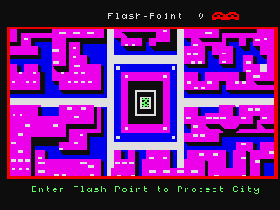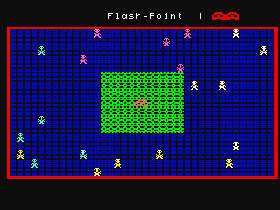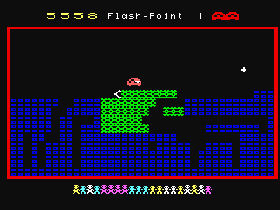 The Game: A zombie infestation has overrun the city. The player, in a mobile unit bristling with weapons, must venture into the infested areas and eliminate the zombies – or die. The center of the infestation screens features a green area surrounding the player’s vehicle; this must be preserved as much as possible while fighting off the zombies, as bonus points are awarded for guarding that space. If the player survives, it’s time to move on to the scene of the next zombie attack. (North American Philips, 1983 – unreleased prototype)
The Game: A zombie infestation has overrun the city. The player, in a mobile unit bristling with weapons, must venture into the infested areas and eliminate the zombies – or die. The center of the infestation screens features a green area surrounding the player’s vehicle; this must be preserved as much as possible while fighting off the zombies, as bonus points are awarded for guarding that space. If the player survives, it’s time to move on to the scene of the next zombie attack. (North American Philips, 1983 – unreleased prototype)
Memories: The only game custom-made specifically for the upgraded hardware of N.A.P.‘s never-released Odyssey3 console, Flash Point is a kind of action game that simply couldn’t have been executed with the same finesse on the Odyssey2.
 Designed by Rex Battenberg (also part of the team behind Taito‘s Zoo Keeper), Flash Point is an obvious homage to the arcade hit Roboton, but it’s a good homage. The Odyssey3 casing was designed to hold the system’s twin joysticks at the back of the main unit, and Flash Point took advantage of that – the player would have to let the machine hold the controllers to allow for a two-joystick multi-directional firing control scheme, like Robotron.
Designed by Rex Battenberg (also part of the team behind Taito‘s Zoo Keeper), Flash Point is an obvious homage to the arcade hit Roboton, but it’s a good homage. The Odyssey3 casing was designed to hold the system’s twin joysticks at the back of the main unit, and Flash Point took advantage of that – the player would have to let the machine hold the controllers to allow for a two-joystick multi-directional firing control scheme, like Robotron.
 Surprisingly, despite the fact that the cancelled Odyssey3 hardware did appear in Europe as the Videopac G7400 console, Flash Point was not available for G7400 owners until very recently, when a limited run of reproductions of the completed prototype were made available by Dieter Koenig of Classic Consoles Center. For whatever reason, it seemed that Philips’ European headquarters – perhaps already responding to a slump in the video game industry there – decided not to issue Battenberg’s completed game. Several G7400+ exclusives, taking advantage of the same advances in the Odyssey3 hardware, were sold in Europe, but for some reason Flash Point was never released there.
Surprisingly, despite the fact that the cancelled Odyssey3 hardware did appear in Europe as the Videopac G7400 console, Flash Point was not available for G7400 owners until very recently, when a limited run of reproductions of the completed prototype were made available by Dieter Koenig of Classic Consoles Center. For whatever reason, it seemed that Philips’ European headquarters – perhaps already responding to a slump in the video game industry there – decided not to issue Battenberg’s completed game. Several G7400+ exclusives, taking advantage of the same advances in the Odyssey3 hardware, were sold in Europe, but for some reason Flash Point was never released there.
 Flash Point is the sole reminder of the promise that some gamers hoped the Odyssey3 would show over the Odyssey2, but with the near-collapse of the industry in 1983, both the console and the game itself were shelved permanently. Flash Point is still somewhat primitive in its graphic and sound treatment (like the Atari 7800, which was saddled with the same sound chip as the 2600, Flash Point seems to point toward the Odyssey3 being stuck with the same sound capabilities of the Odyssey2), and clearly didn’t represent the major advances in gaming circa 1983 that games on such platforms as Colecovision represented. It’s possible that Philips sensed this and made the decision not to release the Odyssey3.
Flash Point is the sole reminder of the promise that some gamers hoped the Odyssey3 would show over the Odyssey2, but with the near-collapse of the industry in 1983, both the console and the game itself were shelved permanently. Flash Point is still somewhat primitive in its graphic and sound treatment (like the Atari 7800, which was saddled with the same sound chip as the 2600, Flash Point seems to point toward the Odyssey3 being stuck with the same sound capabilities of the Odyssey2), and clearly didn’t represent the major advances in gaming circa 1983 that games on such platforms as Colecovision represented. It’s possible that Philips sensed this and made the decision not to release the Odyssey3.
